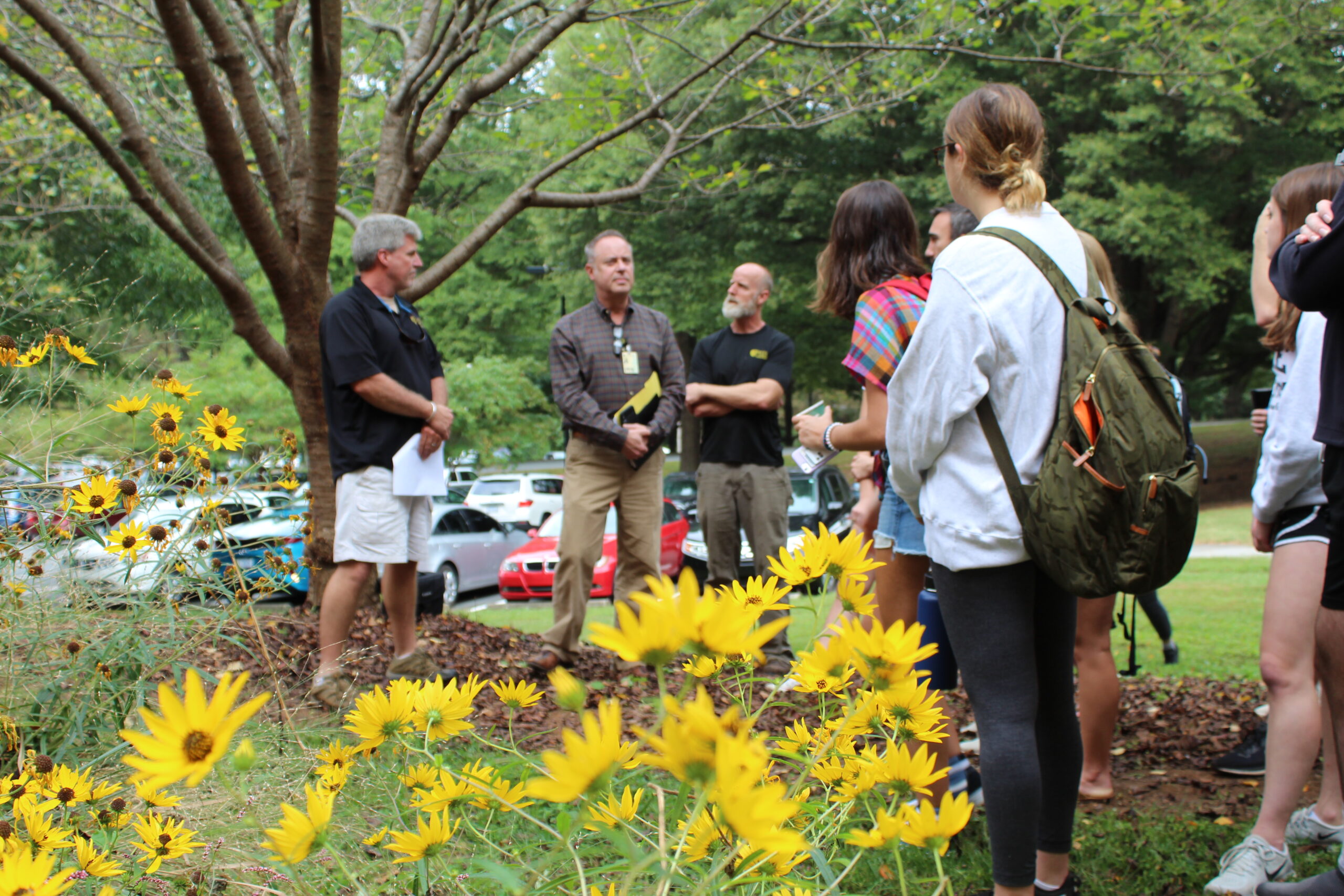“Campus as Lab” Pilot Program Engages Students With a Hands-On Approach to Sustainability

The Campus as Lab Pilot Program engages faculty from all disciplines, inviting students to apply what they learn and solve problems creatively.
Content Development Assistant Adam Tomasi (’19) contributed to this article.
The undergraduate campus at Wake Forest stands out for its iconic architecture and beautiful landscapes. Right off Polo Road, a few-minute’s walk from the North Campus residences, you will find an unexpected landscape: Campus Garden. Once you walk across a lot and past a supply barn, you’ll find rows of seasonal vegetables, plots in cover crops, bee hives, and even chickens. The Campus Garden, and the classes that visit each semester to get a hands-on experience in sustainable agriculture, exemplify the opportunities inherent in a Campus as Lab program.
The concept of a “living lab,” or a classroom that engages students with their physical environment, is taking shape on campuses from Cornell University to the University of Edinburgh. The Office of Sustainability has developed a more formal Campus as Lab program over the past year. Though engaged learning has been a central practice for many faculty for some time, the formal pilot began in November 2017 to promote hands-on learning about sustainability across the curriculum. Matching campus needs with faculty interests takes time and a network of relationships that support the projects.
“Students benefit from opportunities to engage their environment with ‘problem-based learning,’” said Nathan Peifer, Wake Forest’s Campus as Lab and Campus Garden Manager. “We identify sustainability issues on campus, and invite students to create solutions by applying the concepts and skills they are learning in class. Campus as Lab complements classroom learning with hands-on experiences.”
Eight classes have visited the garden each semester over the past year, many of which are first year seminars that address topics of food. Similar courses, with hands-on topics about sustainability, have sprouted beyond the Campus Garden and across the undergraduate campuses.
Innovative courses that engage the campus as a lab include Dr. Jed Macosko’s “Physics and Chemistry of the Environment” (PHY 120). Dr. Macosko’s students worked on “Project Nightlight” this year, a study of the campus’ contribution to light pollution. In this course, students learn, scientifically, how outdoor lighting on campus obstructs our view of the night sky and how the ultimate goal is to achieve energy efficiency, while reducing light pollution.
“They are engaging an issue on campus, but also a broader regional and national problem,” Peifer said. “The Reynolda Campus is a microcosm for global sustainability.”
Several faculty who are activating the Campus as Lab pilot program are alumni of the Magnolias Curriculum Project. This annual spring workshop engages faculty from across the disciplines in the College and the professional schools, who are interested in incorporating sustainability — broadly defined — into their courses.
Dr. Ron Von Burg, a professor of communication and Magnolias alumnus, partnered with Campus as Lab to teach Humanity and Nature (HMN 365) in the spring of 2017. Students cared for a plant from seed to salad at Campus Garden in order to learn and practice empathy for plants’ interactions with their ecosystems.
“After each visit, they would have to reflect on the experience, with particular attention to the ‘perspective’ of the plant within the broader ecosystem,” said Dr. Von Burg. “Students really enjoyed getting out of the classroom and seeing the literal fruits of their labor.”
Campus as Lab weaves traditional academic subjects with the essential questions of sustainability.
“Once you dive into a topic, the interdisciplinary connections become clear,” Peifer said.
Faculty at Wake Forest have long engaged project-based learning opportunities across the curriculum. Dr. Ulrike Wiethaus, a professor in the department for the study of religions, teaches “Contemplative Traditions.” Students in the course first worked at the To Hi Garden in 2011. This area, which surrounds a stormwater retention pond on the southeast corner of campus, is home to native species, walking trails, and as the name suggests in Cherokee, meditation spaces. Not only does Wiethaus’ seminar engage students with contemplative practices, it also teaches them how the pond improves the quality of campus stormwater before it flows into Silas Creek. Students find connections between the cleansing of human and non-human landscapes through engaged practices.
Peifer is optimistic that a more formalized Campus as Lab program will create even more opportunities for student engagement over time.
“There is definitely momentum throughout the university for project-based learning,” he said. “Campus as Lab is just one way students can learn by getting their hands dirty.”
